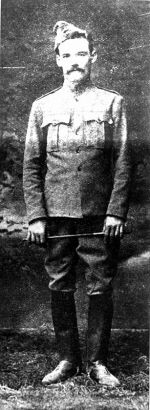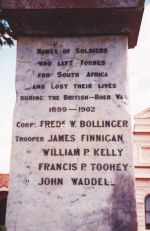Biography – Trooper John Waddell
Regimental No 327 'C' Squadron NSW Bushmen's Contingent
John Waddell was born at Pyree, near Shoalhaven, New South Wales, on 15 March 1872. He was named after his eldest brother, who had died at the age of 16 in 1868. The second John Waddell was the fourteenth child of David Waddell and his wife Elizabeth (nee McTavish) who had emigrated from Scotland prior to their marriage at Moruya, New South Wales, in March 1850.1
John, known as 'Jack' was a horsebreaker, employed by Hedley Edols on his property, Burrawong, near Forbes. His obituary in the Sydney Mail referred to him as a splendid illustration of the Australian bushmen – a crack rider and a perfect master of bushcraft, just the sort of man that proved so effective in combating the Boers at their own game.2 When he enlisted as a member of the 'Forbes Fifty' his employer advised him to secure a good mount and offered him the pick of the station horses. Waddell boldly asked for Edols' favourite horse, Jackpot, a request that was happily granted.3 It was noted by the Sydney Mail that:
All good poker players will have faith in the Forbes troopers, since they open their hand against the Boers with a Jackpot.4
The contingent sailed on 28 February 1900, arrived in Capetown on 2 April and then proceeded via Marandelles to Bulawayo, Rhodesia (Zimbabwe). 'C' Squadron served under Lieutenant Colonel Airey, DSO in a severe engagement at Kloster's River on 22 July. On 4 August the squadron, along with men from other details, defended Eland's River against De la Rey with 1,000 men and guns for 13 days, refusing to surrender on any terms. They were eventually relieved by Lord Kitchener's force on 15 August and Lord Methuen's column which arrived from the north on 18 August 1900.
Jack Waddell was killed on the first day of the siege. The chaplain accompanying the Bushman, the Rev James Green wrote:
We had 32 casualties for this day, five of which were deaths. One of the saddest processions imaginable was the burial party which followed me at midnight, outside the camp, to the place pitched on as our cemetery, where we were to bury our comrades. When the flag was removed from the bodies it was a strange sight which met our eyes. Some of the dead looked almost alive, – they lay there in the attitude assumed at the moment of falling. A gunner lay with his knee drawn up, his hand outstretched and eyes fixed, as though death had come to him at the very moment when he had located the enemy’s gun, and was eagerly pointing it out to his comrades. We buried them there, near the position they died to hold, whilst the silent and statuesque sentry at the foot of the grave stood at attention.5
Details of Waddell's death from a pom-pom shell and subsequent burial were sent to his brother James at Burrawong by Captain J F Thomas of 'A' Squadron:
The NSW Bushmen helped to bury him the same night, along with one of my own men, Trooper James Duff, of Millie Station, another good man. We lay them side by side, with three others, in one grave. We spread a bed of veldt grass beneath them, and a blanket over them. It was a sad duty for us, for we are none of us such hardened soldiers as not to feel the keen grief at the loss of such brave comrades. But it is 'the fortune of war', and it may be better to die thus than to grow old and die of some lingering disease. I cut off a lock of his hair, and have put his small properties together, and will forward them at the earliest moment. They comprise; a writing case (locked, no key); a small inscribed liquor flask; a small bible, etc.6
The burial service did not take place until 17 August. After the troops were relieved, the Rev James Green read the burial service over the graves of Troopers John Waddell, James Duff, James Walker and Sergeant Major James Mitchell. A single piece of slate served as a headstone for the four Bushmen.
In late December, 1900, a number of Waddell's family and school friends gathered at the School of Arts in Pyree to unveil a portrait of the fallen soldier, which bore the inscription –
In Memoriam
To the memory of
Trooper John Waddell
August 3, 1900
Dedicated by his schoolmates and friends
He nobly did
his duty.7
A school friend Peter Ryan who was present, remarked that he:
... could not help thinking that the photograph was a poor substitute for poor Jack Waddell who now lies: –
Under the sod and the dew;
Awaiting the judgement day;
For the sake of the red, white and blue,
He has given his young life away.
Far on the
battlefield he lay,
With the honours of the brave;
Without a line to mark the day,
Or a stone to mark his grave.
Poor Jack Waddell's familiar face
Fresh on our memories yet;
Long may his photo keep its place, –
Lest we forget.
John Waddell is also commemorated in St John's Anglican Church Forbes and on the Boer War Memorial in Forbes Municipal Park.
The original headstone of slate that stood over the graves of Waddell and his three fellow Bushmen is now on display in the Australians in South Africa gallery at the Australian War Memorial, Canberra. A number of years ago, four individual metal crosses replaced this headstone, which was then brought to Australia. A full-length uncaptioned photograph of Waddell is the second displayed on the right hand wall in the entrance to the galleries of the Australian War Memorial.
1 Information from Jacqualine Stevens and Shoalhaven Family History Society Inc. The Nominal Roll of 'C' Squadron, NSW Bushmen's Contingent, National Archives of Australia, microfilm B5204 Folder 2a, gives date of birth as 15 April 1872.
2 The Late John Wadell [sic], Sydney Mail 27 October 1900
3 ibid.
4 The Bushmen, Sydney Mail, 3 February 1900.
5 The Story of the Australian Bushmen (being Notes of a Chaplain), James Green, Sydney, 1903.
6 In Memory of the Dead, Unveiling a memorial to Trooper J Waddell, Nowra Leader, 28 December 1900.
7 ibid – August 3 1900 differs from date of death found in other sources.
8 ibid.





